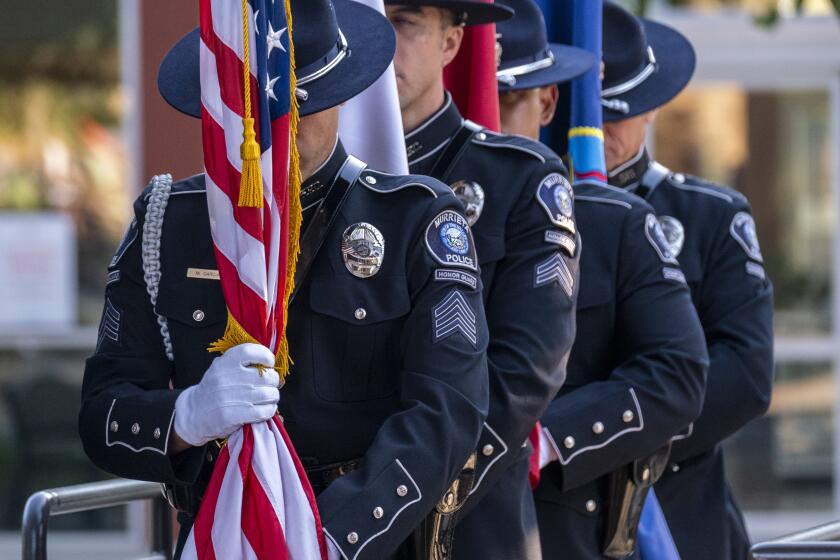Pentagon says the deadly Afghan airport attack was not preventable

- Share via
WASHINGTON — The military investigation into the deadly attack during the Afghanistan evacuation has concluded that a suicide bomber, carrying 20 pounds of explosives packed with ball bearings, acted alone and that the deaths of more than 170 Afghans and 13 U.S. service members were not preventable.
The blast Aug. 26 at Abbey Gate outside the Kabul airport killed 11 U.S. Marines, a sailor and a soldier, who were screening thousands of Afghans frantically trying to get onto one of the crowded flights leaving the country after the Taliban takeover. The Islamic State claimed responsibility for the attack.
At the Pentagon on Friday, military officials laid out a graphic, minute-by-minute account of the bombing. The bottom line, they said, was that those who died had wounds that were “so catastrophic” they couldn’t be overcome. They said that earlier suggestions of a complex attack involving gunfire turned out to be unfounded.
“A single, explosive device killed at least 170 Afghan civilians and 13 U.S. service members by explosively directing ball bearings through a packed crowd and into our men and women at Abbey Gate,” said Gen. Frank McKenzie, head of U.S. Central Command. “The disturbing lethality of this device was confirmed by the 58 U.S. service members who were killed and wounded despite the universal wear of body armor and helmets that did stop ball bearings that impacted them but could not prevent catastrophic injuries to areas not covered.”
Investigators said the bomber probably got near the gate by bypassing the Taliban and other security checkpoints. They said that it appears the Taliban didn’t know of the attack, that security precautions were being taken and that intelligence about potential threats that was circulating that day was not specific.
“Based upon our investigation, at the tactical level this was not preventable,” said Brig. Gen. Lance Curtis, who led the investigation. He added that military leaders in Kabul followed proper security measures, at times closing the gate or pausing the processing of evacuees.
Parents, friends and fellow Marines remember the four young people from California killed in the Kabul airport bombing.
Military officials said gunfire after the blast was found to be warning shots fired by U.S. and British troops, and no one was killed or wounded by gunshots.
McKenzie said the investigation revealed that the 5-millimeter ball bearings in the bomb caused injuries that looked like gunshot wounds. He said some troops in the area fired warning shots, and that led others to believe the attack included gunmen.
Friday’s briefing lasted more than an hour and resembled the detailed explanations military officials gave to the families of the troops killed that day. It included several videos of the chaos at the gate at the time of the bombing.
One shows two Marines in the foreground; deep in the background between them is a glimpse of a single person, dressed in black. There is the sound of an explosion, and a cloud of black smoke rises.
Investigators said the bomber was likely standing on the far side of a sewage canal and was a bit “elevated” when detonating the bomb. Pieces of a backpack were found.
Three service members who were standing on a short wall looking over the crowd were just 10 feet from the blast and were killed. Videos shot from overhead show Marines and others rushing to treat and evacuate the wounded, providing first aid and carrying people over their shoulders as they ran, while civilians scrambled to flee the area.
Marines cut holes in the adjacent fence so they could get to triage areas quickly, while struggling through a fog of tear gas that enveloped the area when the bomb fragments punctured canisters carried by troops.
The deadly bombings came hours after Western intelligence agencies warned of a potential attack.
The blast, said investigators, created “instant chaos and sensory overload.” But within 20 minutes, all of the killed and wounded had been moved to triage sites.
The nearly 20 pages of briefing documents included photos showing the crush of Afghans and others trying to get into the airport, many waving documents and slogging through the sewage trench to get closer to the troops who were processing evacuees. Investigators said that as the Taliban made it more difficult to get through checkpoints, Afghans and others began using side roads and back alleys to get closer to the outer gate.
The investigation concluded that there were enough medical staff and blood supplies around the airport, with nine surgical teams and a hospital. It quoted a trauma surgeon who told investigators, “We had all we needed. Did we need more people? No, we had a lot of experience on the team and plenty of people.”
As the death toll from Thursday’s bombing in Kabul climbs past 180, Afghan families gather for funerals, and many resolve anew to leave.
The number of service members wounded in the bombing grew to 45 in the following days as they were examined. Some were found to have suffered traumatic brain injuries from the blast.
U.S. military officials have said all along that the forces at the gates had a dangerous job. Overall, the U.S.-led coalition evacuated 126,000 people in about three weeks, and the U.S. left Afghanistan for good at about midnight on Aug. 30.
Early on, McKenzie said, troops at the gates had to get close to the people they were screening.
“This is close-up work. The breath of the person you are searching is upon you,” McKenzie said in August, soon after the attack.
More to Read
Sign up for Essential California
The most important California stories and recommendations in your inbox every morning.
You may occasionally receive promotional content from the Los Angeles Times.
















